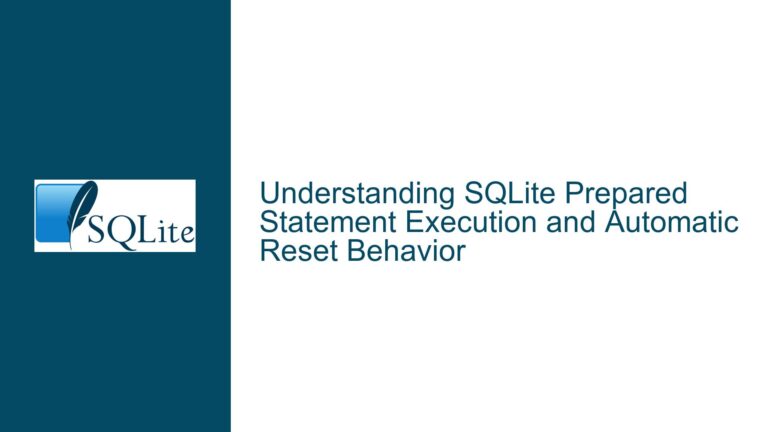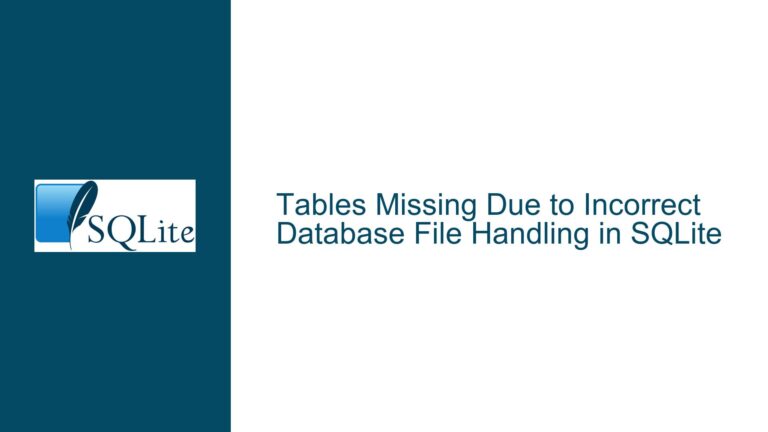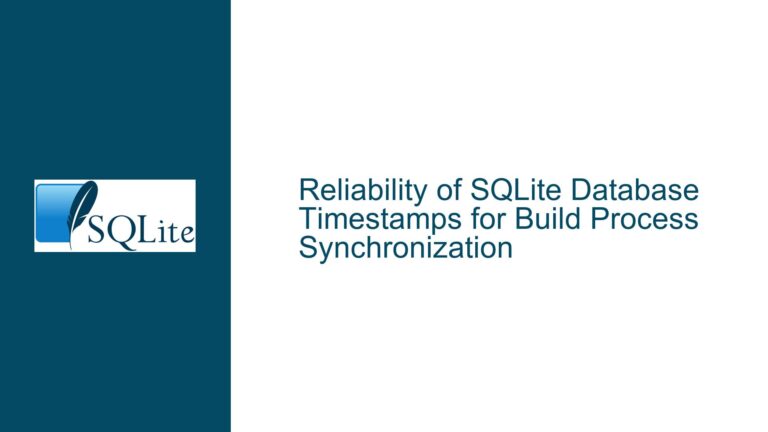Custom FTS Tokenizers in SQLite-WASM: Challenges and Solutions
Issue Overview: Custom FTS Tokenizers in SQLite-WASM
The core issue revolves around the implementation and registration of custom tokenizers for Full-Text Search (FTS) virtual tables in SQLite when using the WebAssembly (WASM) build. Specifically, the discussion highlights the challenges of integrating custom tokenizers for FTS3/4 and FTS5 in a JavaScript environment. The primary concern is whether it is possible to create and bind a custom tokenizer implementation directly from JavaScript or if a custom WASM build of SQLite with C-based tokenizer implementations is required.
The discussion also touches on the limitations of the canonical WASM build of SQLite, which does not include FTS3/4 support, opting instead for FTS5. This decision was made under the assumption that users of the WASM build would prefer to work with the latest features, but this has proven to be a point of contention for those who require FTS3/4 functionality. Additionally, the need for retrieving term offsets from the FTS index is discussed, with FTS3/4 providing an auxiliary offsets function that is not available in FTS5 out of the box. While FTS5 has the necessary data structures to retrieve term offsets, it lacks a built-in auxiliary function to facilitate this, requiring custom implementations.
The discussion further delves into the ongoing efforts to integrate FTS5 customization into the WASM build, including the registration of custom auxiliary functions. However, this effort is still in its early stages, with only partial functionality available and some unresolved issues, such as memory leaks in the xDestroy() callbacks. The timeline for these features to be fully integrated into the SQLite-WASM build is uncertain, with the 3.43 release unlikely to include them.
Possible Causes: Why Custom FTS Tokenizers Are Challenging in SQLite-WASM
The challenges associated with implementing custom FTS tokenizers in SQLite-WASM stem from several factors, including the architectural differences between JavaScript and C, the limitations of the WASM build, and the complexity of the FTS API.
First, the architectural differences between JavaScript and C present a significant hurdle. SQLite’s FTS tokenizers are traditionally implemented in C, leveraging low-level memory management and direct pointer manipulation. JavaScript, on the other hand, operates in a higher-level, garbage-collected environment, making it difficult to directly interface with C-based tokenizer modules. This discrepancy necessitates a bridge between the two environments, which is not straightforward to implement.
Second, the canonical WASM build of SQLite does not include FTS3/4 support, focusing instead on FTS5. This decision was made to reduce the maintenance burden associated with supporting older or deprecated features in a new platform like WASM. However, this has left users who require FTS3/4 functionality in a difficult position, as they must either switch to FTS5 or create a custom WASM build that includes FTS3/4 support. The latter option is non-trivial, requiring a deep understanding of both SQLite’s internals and the WASM build process.
Third, the complexity of the FTS API adds another layer of difficulty. The FTS API, particularly for FTS5, is intricate and requires a thorough understanding of how tokenizers and auxiliary functions interact with the database. Custom tokenizers must adhere to the sqlite3_tokenizer_module interface, which defines a set of functions that the tokenizer must implement. Similarly, custom auxiliary functions must conform to the Fts5ExtensionApi interface. These interfaces are designed with C in mind, and adapting them to work seamlessly with JavaScript is a non-trivial task.
Finally, the ongoing development of FTS5 customization in the WASM build introduces additional challenges. While progress has been made in registering custom auxiliary functions, the implementation is not yet complete. Issues such as memory leaks in the xDestroy() callbacks highlight the complexities involved in ensuring that the JavaScript bindings for these functions are both functional and efficient. The timeline for resolving these issues is uncertain, further complicating the situation for users who require these features.
Troubleshooting Steps, Solutions & Fixes: Addressing Custom FTS Tokenizer Challenges in SQLite-WASM
Given the challenges outlined above, several steps can be taken to address the issues related to custom FTS tokenizers in SQLite-WASM. These steps include leveraging existing workarounds, creating custom WASM builds, and contributing to the ongoing development efforts.
Leveraging Existing Workarounds: For users who require FTS3/4 functionality, one possible workaround is to use an unofficial WASM build that includes FTS3/4 support. As mentioned in the discussion, the @sqlite.org/wasm version appears to include FTS3/4, and it has been reported to work in certain applications. While this is not a long-term solution, it can serve as a stopgap measure until official support is added.
Creating Custom WASM Builds: For users with specific requirements that cannot be met by the canonical WASM build, creating a custom WASM build of SQLite may be necessary. This involves compiling SQLite from source with the desired features enabled, including FTS3/4 support. While this approach requires a deep understanding of SQLite’s build process and the WASM toolchain, it provides the most flexibility in terms of feature inclusion. Detailed documentation on building SQLite for WASM can be found on the SQLite website, and community forums can provide additional guidance.
Contributing to Development Efforts: For users who are comfortable with C and JavaScript, contributing to the ongoing development of FTS5 customization in the WASM build is another option. The discussion highlights that work has already begun on integrating FTS5 auxiliary functions into the WASM build, and contributions from the community could help accelerate this process. By participating in the development effort, users can help ensure that the features they need are prioritized and implemented correctly.
Implementing Custom Auxiliary Functions in FTS5: For users who require term offsets in FTS5, implementing custom auxiliary functions is a potential solution. While FTS5 does not provide a built-in offsets function, it does offer an API for registering custom auxiliary functions. By implementing a custom auxiliary function in C and exposing it via the WASM build, users can achieve the desired functionality. This approach requires a thorough understanding of the FTS5 API and the ability to write and debug C code, but it provides a way to extend FTS5’s capabilities to meet specific needs.
Addressing Memory Leaks in xDestroy() Callbacks: One of the issues mentioned in the discussion is a memory leak involving the xDestroy() callbacks for FTS5 auxiliary functions. This issue arises because the JavaScript bindings for these functions are not properly cleaned up when the database is closed. To address this, developers can investigate the source of the leak and implement fixes in the WASM build. This may involve modifying the way xDestroy() callbacks are handled in the JavaScript bindings or ensuring that all resources are properly released when the database is closed. Detailed debugging and testing will be required to identify and resolve the root cause of the leak.
Exploring Alternative Solutions: In some cases, it may be worth exploring alternative solutions that do not rely on custom FTS tokenizers. For example, if the primary requirement is full-text search with term offsets, it may be possible to achieve this using a different approach, such as preprocessing the text data before inserting it into the database or using a different search engine that better meets the requirements. While this may not be ideal, it can provide a viable alternative when custom tokenizers are not feasible.
Staying Informed and Engaged: Finally, staying informed about the latest developments in SQLite-WASM and engaging with the community can help users stay ahead of potential issues. The SQLite forum is an excellent resource for keeping up with the latest updates, and participating in discussions can provide valuable insights and solutions. By staying engaged, users can ensure that they are aware of new features and improvements as they are released, and they can contribute to the ongoing development of SQLite-WASM.
In conclusion, while implementing custom FTS tokenizers in SQLite-WASM presents several challenges, there are multiple approaches to addressing these issues. By leveraging existing workarounds, creating custom WASM builds, contributing to development efforts, and exploring alternative solutions, users can overcome the limitations of the current implementation and achieve their desired functionality. As the development of SQLite-WASM continues, it is likely that many of these challenges will be addressed, providing users with even greater flexibility and capabilities in their applications.






